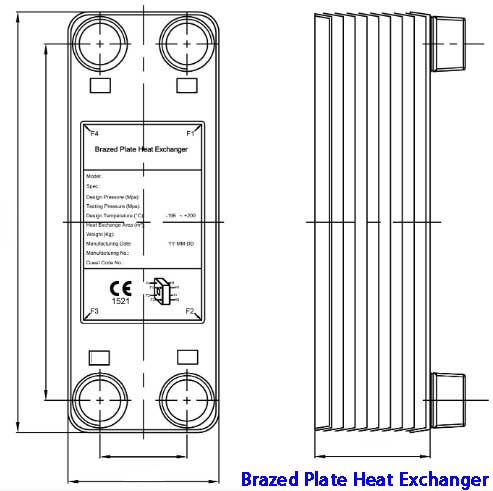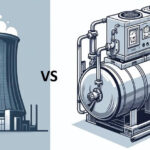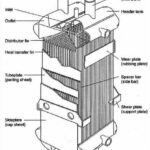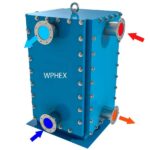Brazed plate heat exchangers are a type of heat exchanger that are used to transfer heat between two fluid streams, such as between a hot fluid and a cold fluid. They consist of a series of thin, corrugated metal plates that are brazed together using a high-temperature brazing process. The fluid streams flow through the plate heat exchanger in separate channels, and heat is transferred from one fluid stream to the other through the metal plates.
Brazed plate heat exchangers are commonly used in a variety of applications, including HVAC systems, refrigeration systems, and industrial processes that require heat transfer. They are particularly well-suited for applications that require a compact, efficient, and durable heat exchanger.
Advantages of brazed plate heat exchangers
- High heat transfer efficiency: The thin, corrugated plates provide a large surface area for heat transfer, resulting in high heat transfer efficiency.
- Compact design: Brazed plate heat exchangers have a compact design, which makes them ideal for applications where space is limited.
- Durability: Brazing provides a strong, leak-proof bond between the plates, making brazed plate heat exchangers durable and long-lasting.
- Easy maintenance: The simple design of brazed plate heat exchangers makes them easy to maintain and clean.
- Cost-effective: Brazed plate heat exchangers are a cost-effective option compared to other types of heat exchangers, particularly for small-scale applications.
Disadvantages of brazed plate heat exchangers
While brazed plate heat exchangers have several advantages, there are also some disadvantages to consider:
- Limited pressure and temperature range: Brazed plate heat exchangers are designed to operate within a limited range of pressures and temperatures. If the fluid streams being exchanged have temperature or pressure requirements outside of this range, a different type of heat exchanger may be needed.
- Risk of corrosion: If the fluid streams being exchanged have corrosive properties, the metal plates of the brazed plate heat exchanger may become corroded, reducing the efficiency and lifespan of the heat exchanger.
- Potential for fouling: If the fluid streams contain particles or debris that can clog the small channels between the metal plates, the efficiency of the heat exchanger may be reduced.
- Limitations for high viscosity fluids: Brazed plate heat exchangers are not well-suited for applications that involve high viscosity fluids, as the fluids may not flow easily through the small channels between the metal plates.
- Service limitations: In the event of a problem with the brazed plate heat exchanger, repairing or servicing the heat exchanger may require specialized knowledge and equipment.
These disadvantages should be carefully considered when deciding whether a brazed plate heat exchanger is the best choice for a particular application. In some cases, another type of heat exchanger may be more suitable, depending on the specific requirements of the application.
Brazed plate heat exchangers applications
Brazed plate heat exchangers (BPHEs) are compact, efficient, and versatile devices that are used to transfer heat from one fluid to another. Here are some of the common applications and uses of brazed plate heat exchangers:
- HVAC: BPHEs are used in heating, ventilation, and air conditioning (HVAC) systems to transfer heat between the hot and cold sides of the system. They are particularly useful for cooling applications, such as air conditioning, as they can handle high temperature differentials and provide good thermal efficiency.
- Industrial processes: BPHEs are used in a variety of industrial processes that require heat transfer. They are particularly useful in applications that involve corrosive or viscous fluids, as they can withstand the high pressures and temperatures associated with these processes.
- Refrigeration: BPHEs are used in refrigeration systems to transfer heat between the refrigerant and the cooling medium. They are particularly useful in compact refrigeration systems, such as those used in small appliances or automotive air conditioning.
- Renewable energy: BPHEs are used in a variety of renewable energy systems, such as solar hot water systems and geothermal heat pumps, to transfer heat between the energy source and the heat storage or distribution system.
- Food and beverage processing: BPHEs are used in the food and beverage industry to heat or cool liquids during the manufacturing process. They are particularly useful for heating or cooling viscous liquids, such as milk or syrup, as they can provide a large surface area for heat transfer.
Overall, BPHEs are used in a wide range of applications that require efficient and reliable heat transfer. Their compact size, high thermal efficiency, and ability to handle corrosive and viscous fluids make them an ideal choice for many different industries and applications.
Thermal design
The thermal design of a brazed plate heat exchanger (BPHE) involves calculating the heat transfer rates, pressure drops, and other performance parameters to ensure that the exchanger meets the specific requirements of the application. Here are some general steps that can be followed to perform thermal design for a BPHE:
- Determine the heat duty: The first step in designing a BPHE is to determine the amount of heat that needs to be transferred between the two fluids. This can be calculated using the heat transfer equation Q = U x A x ΔT, where Q is the heat duty, U is the overall heat transfer coefficient, A is the heat transfer area, and ΔT is the temperature difference between the two fluids.
- Select the BPHE type and size: Once the heat duty has been determined, the next step is to select the appropriate BPHE type and size based on the application requirements. This involves considering factors such as the flow rates, pressure drops, and temperature ranges of the two fluids, as well as any other specific requirements such as corrosion resistance or compact size.
- Calculate the heat transfer coefficient: The heat transfer coefficient is a measure of the ability of the BPHE to transfer heat between the two fluids. It is influenced by factors such as the flow rates, the fluid properties, and the design of the BPHE. The heat transfer coefficient can be calculated using empirical correlations or computational fluid dynamics (CFD) simulations.
- Calculate the pressure drop: The pressure drop is a measure of the resistance to flow through the BPHE, and is influenced by factors such as the flow rates, the fluid properties, and the design of the BPHE. The pressure drop can be calculated using empirical correlations or CFD simulations.
- Determine the fouling factor: Fouling is the accumulation of deposits on the heat transfer surfaces, which can reduce the heat transfer efficiency of the BPHE over time. The fouling factor can be estimated based on the fluid properties and the application conditions, and is used to account for the reduction in heat transfer efficiency due to fouling.
- Optimize the design: Finally, the design of the BPHE can be optimized to achieve the desired performance parameters, such as maximum heat transfer efficiency or minimum pressure drop. This can involve adjusting factors such as the plate geometry, the fluid flow patterns, or the materials used.
In general, the thermal design of a BPHE involves a careful balance of factors such as heat transfer, pressure drop, and fouling, and requires an understanding of fluid mechanics, thermodynamics, and heat transfer principles.
Difference between Brazed plate heat exchangers and Gasketed plate heat exchangers
The main difference between gasketed plate heat exchangers (GPHEs) and brazed plate heat exchangers (BPHEs) is the way the plates are sealed together.
In GPHEs, the plates are assembled with gaskets, which are typically made of elastomeric materials such as NBR, EPDM, or Viton. The gaskets provide a seal between adjacent plates and form separate flow channels for the hot and cold fluids. The plates are then clamped together with a frame, which applies pressure to the gaskets and ensures that the plates are tightly sealed.
In BPHEs, the plates are brazed together using a filler material such as copper or nickel. The brazing process creates a permanent bond between the plates, which eliminates the need for gaskets and frames. The brazed joints also provide a high degree of structural integrity and resistance to thermal and mechanical stress.
There are several advantages and disadvantages to each type of heat exchanger:
GPHEs are typically less expensive than BPHEs and can be disassembled for cleaning or maintenance. They also allow for flexibility in changing the heat transfer area by adding or removing plates, and they are suitable for a wide range of fluid types and flow rates. However, they may require more maintenance than BPHEs due to the potential for gasket failure, and they are generally not suitable for high-temperature or high-pressure applications.
BPHEs are generally more compact and efficient than GPHEs, due to the elimination of gaskets and frames and the high thermal conductivity of the brazed joints. They also have a higher pressure and temperature tolerance, making them suitable for a wider range of applications. However, they are generally more expensive than GPHEs and cannot be disassembled for cleaning or maintenance. They are also more sensitive to thermal stress and may not be suitable for fluids with high chloride content or other corrosive properties.
BPHEs are generally more compact and efficient than GPHEs, due to the elimination of gaskets and frames and the high thermal conductivity of the brazed joints. They also have a higher pressure and temperature tolerance, making them suitable for a wider range of applications. However, they are generally more expensive than GPHEs and cannot be disassembled for cleaning or maintenance. They are also more sensitive to thermal stress and may not be suitable for fluids with high chloride content or other corrosive properties.
| Description | Gasketed plate heat exchangers | Brazed plate heat exchangers |
|---|---|---|
| Price | Cheaper | More expensive |
| Footprint | Less compact | More compact |
| Assembly for cleaning | Easy to disassemble | Can’t be disassembled |
| Maintenance | More maintenance due to potential of gasket failure | Less due to elimination of gaskets |
The choice between a GPHE and a BPHE depends on the specific application and the desired performance and cost criteria. In general, BPHEs are better suited for applications that require high efficiency, compact size, and high reliability, while GPHEs are more suitable for applications that require flexibility, ease of maintenance, and low cost.
Useful software
Gasketed plate heat exchanger design – perform thermal design and analysis on gasketed plate heat exchangers












